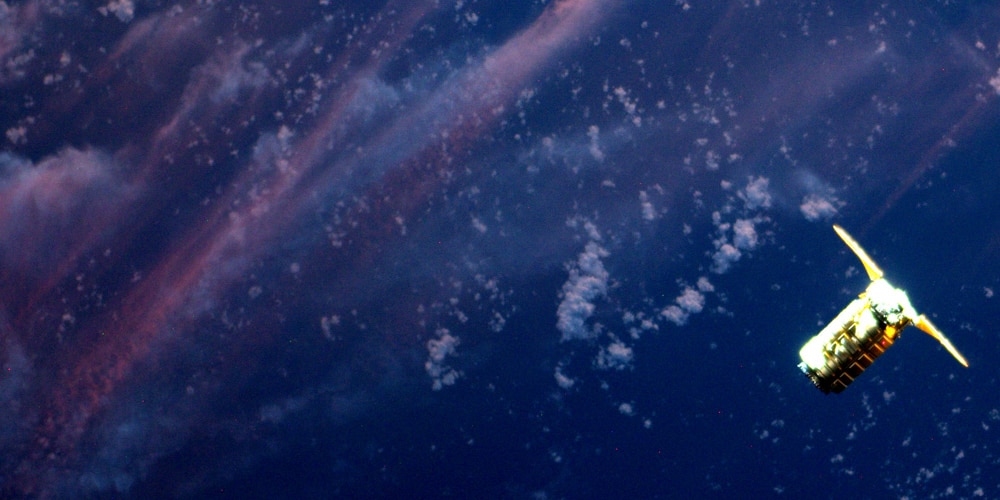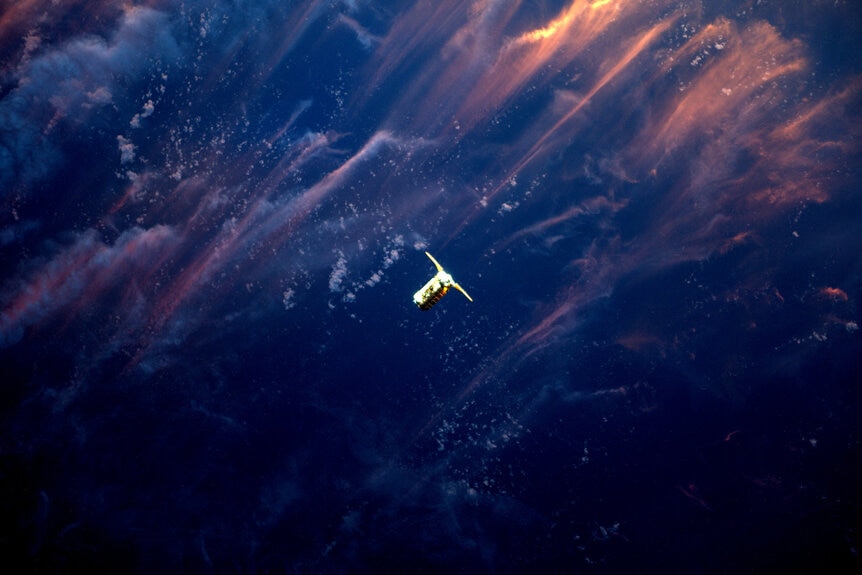Create a free profile to get unlimited access to exclusive videos, sweepstakes, and more!
Spaceships rendezvous as they sail into the sunset

I have no idea how I missed this when it happened, but check out this ridiculously beautiful photograph of an Orbital ATK Cygnus spacecraft approaching the International Space Station!
Yegads (and oh my yes, click that to embiggen it). The spacecraft, named the S.S. John Glenn, launched from Cape Canaveral on April 18, 2017, on top of an Atlas V rocket. Four days later, it approached the ISS, and this photo was snapped by astronaut Thomas Pesquet as they both sailed into the night side of the Earth. The higher-altitude cirrus clouds were lit by the Sun just as it was setting from their vantage point, so they’re lit pink and orange, while lower clouds are already darkening in twilight.
Here’s a video of the launch, including the view from a rocketcam (make sure you see the first stage fall away at the five-minute mark):
John Glenn was carrying nearly four tons of equipment and supplies for the crew on board ISS. It’ll stay berthed to ISS for about three months, during which time (after everything is offloaded) it will be used as a space trash can, filled with material no longer needed on the station. Why? Because in July it will be released and sent on a trajectory that will drop it into Earth’s atmosphere, where it will burn up as it rams through the air. It’s a natural trash compactor/incinerator!
And while I’m thinking about it ... have you ever seen a meteor burning up? They zip across the sky pretty fast, because they’re moving at interplanetary velocities, between 20 and 100 kilometers per second! But if you’ve ever watched a satellite pass overhead they appear to move much more slowly. That’s because they are moving more slowly; orbital speeds are typically 8 km/sec or less (also, satellites are hundred or thousands of kilometers above the Earth’s surface, while meteors burn up at a height of only 100 km, which multiplies the apparent speed difference).
So the John Glenn, when it comes back, will move far more slowly than a “natural” meteor, but plenty fast enough to get hot enough to vaporize a lot of it. Mind you also, it’s not due to friction! Material entering our atmosphere gets hot because it compresses the air in front of it.
Remember, way back in your chemistry class, learning the Ideal Gas Law? It relates the temperature of a gas to its pressure and volume. It says that if you compress a gas, it will heat up. If you compress it a lot, it’ll heat up a lot. So, an object entering Earth’s atmosphere at, say, 30 times the speed of sound is going to slam into the air, squeezing it really hard —in fact, you need to account for the shock wave since the meteoroid is moving at hypersonic speeds as well; the full-up calculation is a bit complex. In the end, the gas heats up to several thousand degrees, causing some of its constituents to glow (causing the meteor phenomenon) and heating up the object as well.
So the (considerable) energy of motion of the object is converted to light and heat. Meteors come in so quickly and generally so steeply that they decelerate hugely, slowing to subsonic speeds in just a few seconds. They get very bright and can vaporize entirely (unless they’re too big). Human-made debris generally is put on a more oblique entry path so it decelerates less rapidly, but the time it takes to drop to subsonic speeds takes longer. This gives it more time to melt away, lowering the risk of big pieces hitting the surface. I’ll add that controlled re-entries are usually done over the Pacific Ocean anyway, so the odds of anything hitting over land are remote. It’s a big ocean.
The next time you see a shooting star, think on that! They’re beautiful, but that beauty is the product of some pretty complex physics. But then, that’s usually the case.
The next Orbital ATK Cygnus launch is scheduled for September 2017.



























